Longteng Guo
Towards Unified Referring Expression Segmentation Across Omni-Level Visual Target Granularities
Apr 02, 2025Abstract:Referring expression segmentation (RES) aims at segmenting the entities' masks that match the descriptive language expression. While traditional RES methods primarily address object-level grounding, real-world scenarios demand a more versatile framework that can handle multiple levels of target granularity, such as multi-object, single object or part-level references. This introduces great challenges due to the diverse and nuanced ways users describe targets. However, existing datasets and models mainly focus on designing grounding specialists for object-level target localization, lacking the necessary data resources and unified frameworks for the more practical multi-grained RES. In this paper, we take a step further towards visual granularity unified RES task. To overcome the limitation of data scarcity, we introduce a new multi-granularity referring expression segmentation (MRES) task, alongside the RefCOCOm benchmark, which includes part-level annotations for advancing finer-grained visual understanding. In addition, we create MRES-32M, the largest visual grounding dataset, comprising over 32.2M masks and captions across 1M images, specifically designed for part-level vision-language grounding. To tackle the challenges of multi-granularity RES, we propose UniRES++, a unified multimodal large language model that integrates object-level and part-level RES tasks. UniRES++ incorporates targeted designs for fine-grained visual feature exploration. With the joint model architecture and parameters, UniRES++ achieves state-of-the-art performance across multiple benchmarks, including RefCOCOm for MRES, gRefCOCO for generalized RES, and RefCOCO, RefCOCO+, RefCOCOg for classic RES. To foster future research into multi-grained visual grounding, our RefCOCOm benchmark, MRES-32M dataset and model UniRES++ will be publicly available at https://github.com/Rubics-Xuan/MRES.
FlexVLN: Flexible Adaptation for Diverse Vision-and-Language Navigation Tasks
Mar 18, 2025Abstract:The aspiration of the Vision-and-Language Navigation (VLN) task has long been to develop an embodied agent with robust adaptability, capable of seamlessly transferring its navigation capabilities across various tasks. Despite remarkable advancements in recent years, most methods necessitate dataset-specific training, thereby lacking the capability to generalize across diverse datasets encompassing distinct types of instructions. Large language models (LLMs) have demonstrated exceptional reasoning and generalization abilities, exhibiting immense potential in robot action planning. In this paper, we propose FlexVLN, an innovative hierarchical approach to VLN that integrates the fundamental navigation ability of a supervised-learning-based Instruction Follower with the robust generalization ability of the LLM Planner, enabling effective generalization across diverse VLN datasets. Moreover, a verification mechanism and a multi-model integration mechanism are proposed to mitigate potential hallucinations by the LLM Planner and enhance execution accuracy of the Instruction Follower. We take REVERIE, SOON, and CVDN-target as out-of-domain datasets for assessing generalization ability. The generalization performance of FlexVLN surpasses that of all the previous methods to a large extent.
Efficient Motion-Aware Video MLLM
Mar 17, 2025Abstract:Most current video MLLMs rely on uniform frame sampling and image-level encoders, resulting in inefficient data processing and limited motion awareness. To address these challenges, we introduce EMA, an Efficient Motion-Aware video MLLM that utilizes compressed video structures as inputs. We propose a motion-aware GOP (Group of Pictures) encoder that fuses spatial and motion information within a GOP unit in the compressed video stream, generating compact, informative visual tokens. By integrating fewer but denser RGB frames with more but sparser motion vectors in this native slow-fast input architecture, our approach reduces redundancy and enhances motion representation. Additionally, we introduce MotionBench, a benchmark for evaluating motion understanding across four motion types: linear, curved, rotational, and contact-based. Experimental results show that EMA achieves state-of-the-art performance on both MotionBench and popular video question answering benchmarks, while reducing inference costs. Moreover, EMA demonstrates strong scalability, as evidenced by its competitive performance on long video understanding benchmarks.
VRoPE: Rotary Position Embedding for Video Large Language Models
Feb 17, 2025Abstract:Rotary Position Embedding (RoPE) has shown strong performance in text-based Large Language Models (LLMs), but extending it to video remains a challenge due to the intricate spatiotemporal structure of video frames. Existing adaptations, such as RoPE-3D, attempt to encode spatial and temporal dimensions separately but suffer from two major limitations: positional bias in attention distribution and disruptions in video-text transitions. To overcome these issues, we propose Video Rotary Position Embedding (VRoPE), a novel positional encoding method tailored for Video-LLMs. Our approach restructures positional indices to preserve spatial coherence and ensure a smooth transition between video and text tokens. Additionally, we introduce a more balanced encoding strategy that mitigates attention biases, ensuring a more uniform distribution of spatial focus. Extensive experiments on Vicuna and Qwen2 across different model scales demonstrate that VRoPE consistently outperforms previous RoPE variants, achieving significant improvements in video understanding, temporal reasoning, and retrieval tasks. Code will be available at https://github.com/johncaged/VRoPE
ChatSearch: a Dataset and a Generative Retrieval Model for General Conversational Image Retrieval
Oct 24, 2024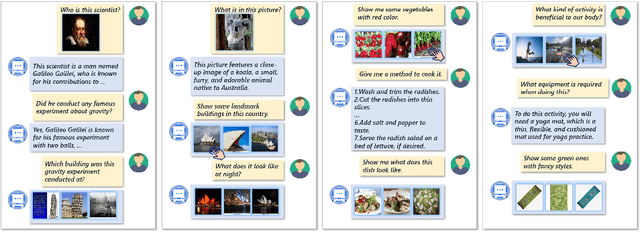
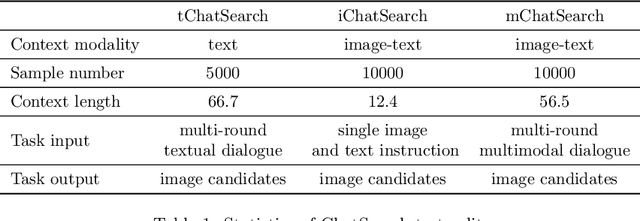
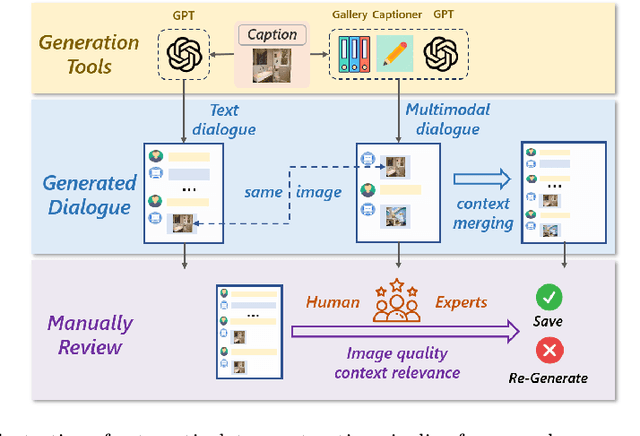

Abstract:In this paper, we investigate the task of general conversational image retrieval on open-domain images. The objective is to search for images based on interactive conversations between humans and computers. To advance this task, we curate a dataset called ChatSearch. This dataset includes a multi-round multimodal conversational context query for each target image, thereby requiring the retrieval system to find the accurate image from database. Simultaneously, we propose a generative retrieval model named ChatSearcher, which is trained end-to-end to accept/produce interleaved image-text inputs/outputs. ChatSearcher exhibits strong capability in reasoning with multimodal context and can leverage world knowledge to yield visual retrieval results. It demonstrates superior performance on the ChatSearch dataset and also achieves competitive results on other image retrieval tasks and visual conversation tasks. We anticipate that this work will inspire further research on interactive multimodal retrieval systems. Our dataset will be available at https://github.com/joez17/ChatSearch.
Ada-K Routing: Boosting the Efficiency of MoE-based LLMs
Oct 15, 2024



Abstract:In the era of Large Language Models (LLMs), Mixture-of-Experts (MoE) architectures offer a promising approach to managing computational costs while scaling up model parameters. Conventional MoE-based LLMs typically employ static Top-K routing, which activates a fixed and equal number of experts for each token regardless of their significance within the context. In this paper, we propose a novel Ada-K routing strategy that dynamically adjusts the number of activated experts for each token, thereby improving the balance between computational efficiency and model performance. Specifically, our strategy incorporates learnable and lightweight allocator modules that decide customized expert resource allocation tailored to the contextual needs for each token. These allocators are designed to be fully pluggable, making it broadly applicable across all mainstream MoE-based LLMs. We leverage the Proximal Policy Optimization (PPO) algorithm to facilitate an end-to-end learning process for this non-differentiable decision-making framework. Extensive evaluations on four popular baseline models demonstrate that our Ada-K routing method significantly outperforms conventional Top-K routing. Compared to Top-K, our method achieves over 25% reduction in FLOPs and more than 20% inference speedup while still improving performance across various benchmarks. Moreover, the training of Ada-K is highly efficient. Even for Mixtral-8x22B, a MoE-based LLM with more than 140B parameters, the training time is limited to 8 hours. Detailed analysis shows that harder tasks, middle layers, and content words tend to activate more experts, providing valuable insights for future adaptive MoE system designs. Both the training code and model checkpoints will be publicly available.
MM-LDM: Multi-Modal Latent Diffusion Model for Sounding Video Generation
Oct 02, 2024Abstract:Sounding Video Generation (SVG) is an audio-video joint generation task challenged by high-dimensional signal spaces, distinct data formats, and different patterns of content information. To address these issues, we introduce a novel multi-modal latent diffusion model (MM-LDM) for the SVG task. We first unify the representation of audio and video data by converting them into a single or a couple of images. Then, we introduce a hierarchical multi-modal autoencoder that constructs a low-level perceptual latent space for each modality and a shared high-level semantic feature space. The former space is perceptually equivalent to the raw signal space of each modality but drastically reduces signal dimensions. The latter space serves to bridge the information gap between modalities and provides more insightful cross-modal guidance. Our proposed method achieves new state-of-the-art results with significant quality and efficiency gains. Specifically, our method achieves a comprehensive improvement on all evaluation metrics and a faster training and sampling speed on Landscape and AIST++ datasets. Moreover, we explore its performance on open-domain sounding video generation, long sounding video generation, audio continuation, video continuation, and conditional single-modal generation tasks for a comprehensive evaluation, where our MM-LDM demonstrates exciting adaptability and generalization ability.
OneDiff: A Generalist Model for Image Difference
Jul 08, 2024



Abstract:In computer vision, Image Difference Captioning (IDC) is crucial for accurately describing variations between closely related images. Traditional IDC methods often rely on specialist models, which restrict their applicability across varied contexts. This paper introduces the OneDiff model, a novel generalist approach that utilizes a robust vision-language model architecture, integrating a siamese image encoder with a Visual Delta Module. This innovative configuration allows for the precise detection and articulation of fine-grained differences between image pairs. OneDiff is trained through a dual-phase strategy, encompassing Coupled Sample Training and multi-task learning across a diverse array of data types, supported by our newly developed DiffCap Dataset. This dataset merges real-world and synthetic data, enhancing the training process and bolstering the model's robustness. Extensive testing on diverse IDC benchmarks, such as Spot-the-Diff, CLEVR-Change, and Birds-to-Words, shows that OneDiff consistently outperforms existing state-of-the-art models in accuracy and adaptability, achieving improvements of up to 85\% CIDEr points in average. By setting a new benchmark in IDC, OneDiff paves the way for more versatile and effective applications in detecting and describing visual differences. The code, models, and data will be made publicly available.
Needle In A Video Haystack: A Scalable Synthetic Framework for Benchmarking Video MLLMs
Jun 13, 2024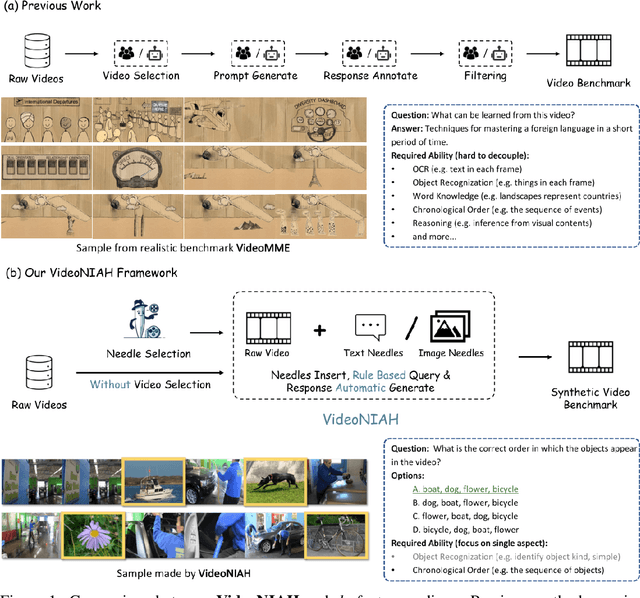
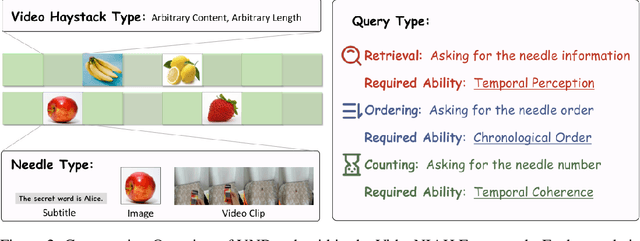
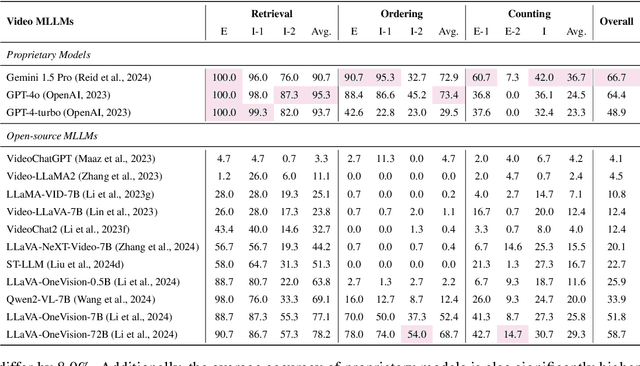
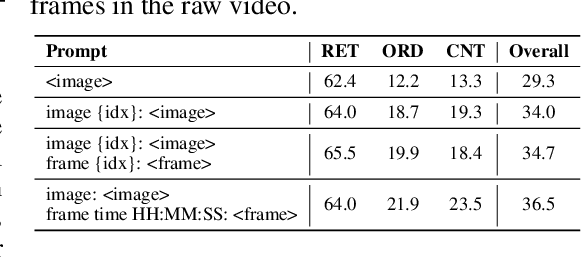
Abstract:Video understanding is a crucial next step for multimodal large language models (MLLMs). To probe specific aspects of video understanding ability, existing video benchmarks typically require careful video selection based on the target capability, along with laborious annotation of query-response pairs to match the specific video content. This process is both challenging and resource-intensive. In this paper, we propose VideoNIAH (Video Needle In A Haystack), a benchmark construction framework through synthetic video generation. VideoNIAH decouples test video content from their query-responses by inserting unrelated image/text 'needles' into original videos. It generates annotations solely from these needles, ensuring diversity in video sources and a variety of query-responses. Additionally, by inserting multiple needles, VideoNIAH rigorously evaluates the temporal understanding capabilities of models. We utilized VideoNIAH to compile a video benchmark VNBench, including tasks such as retrieval, ordering, and counting. VNBench can efficiently evaluate the fine-grained understanding ability and spatio-temporal modeling ability of a video model, while also supporting the long-context evaluation. Additionally, we evaluated recent video-centric multimodal large language models (MLLMs), both open-source and proprietary, providing a comprehensive analysis. We found that although proprietary models have significant advantages over open-source models, all existing video models still perform poorly on long-distance dependency tasks. VideoNIAH is a simple yet highly scalable benchmark construction framework, and we believe it will inspire future video benchmark works. The code and data are available at https://github.com/joez17/VideoNIAH.
Boter: Bootstrapping Knowledge Selection and Question Answering for Knowledge-based VQA
Apr 22, 2024



Abstract:Knowledge-based Visual Question Answering (VQA) requires models to incorporate external knowledge to respond to questions about visual content. Previous methods mostly follow the "retrieve and generate" paradigm. Initially, they utilize a pre-trained retriever to fetch relevant knowledge documents, subsequently employing them to generate answers. While these methods have demonstrated commendable performance in the task, they possess limitations: (1) they employ an independent retriever to acquire knowledge solely based on the similarity between the query and knowledge embeddings, without assessing whether the knowledge document is truly conducive to helping answer the question; (2) they convert the image into text and then conduct retrieval and answering in natural language space, which may not ensure comprehensive acquisition of all image information. To address these limitations, we propose Boter, a novel framework designed to bootstrap knowledge selection and question answering by leveraging the robust multimodal perception capabilities of the Multimodal Large Language Model (MLLM). The framework consists of two modules: Selector and Answerer, where both are initialized by the MLLM and parameter-efficiently finetuned in a simple cycle: find key knowledge in the retrieved knowledge documents using the Selector, and then use them to finetune the Answerer to predict answers; obtain the pseudo-labels of key knowledge documents based on the predictions of the Answerer and weak supervision labels, and then finetune the Selector to select key knowledge; repeat. Our framework significantly enhances the performance of the baseline on the challenging open-domain Knowledge-based VQA benchmark, OK-VQA, achieving a state-of-the-art accuracy of 62.83%.
 Add to Chrome
Add to Chrome Add to Firefox
Add to Firefox Add to Edge
Add to Edge